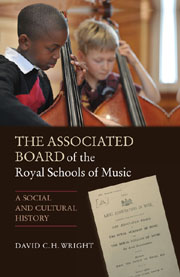Book contents
- Frontmatter
- Contents
- List of Illustrations
- List of Tables
- Dedication
- Preface
- List of Abbreviations
- Miscellaneous Conventions
- Introduction: The Context for a History
- I THE BACKGROUND
- II THE BOARD ESTABLISHED, 1889–1920
- III THE INSTITUTIONAL CULTURE, 1920–83
- IV THE BOARD REVIVED, 1983–2009
- 10 The Reconstitution, 1983–5
- 11 Reconnecting with its Market: the Smith Years, 1983–92
- 12 Redefining its Role: the Morris Years, 1993–2009
- Appendix 1 Speech and Drama Examinations
- Appendix 2 ABRSM Personalia, 1889–2010
- Select Bibliography
- Index
10 - The Reconstitution, 1983–5
from IV - THE BOARD REVIVED, 1983–2009
Published online by Cambridge University Press: 05 July 2013
- Frontmatter
- Contents
- List of Illustrations
- List of Tables
- Dedication
- Preface
- List of Abbreviations
- Miscellaneous Conventions
- Introduction: The Context for a History
- I THE BACKGROUND
- II THE BOARD ESTABLISHED, 1889–1920
- III THE INSTITUTIONAL CULTURE, 1920–83
- IV THE BOARD REVIVED, 1983–2009
- 10 The Reconstitution, 1983–5
- 11 Reconnecting with its Market: the Smith Years, 1983–92
- 12 Redefining its Role: the Morris Years, 1993–2009
- Appendix 1 Speech and Drama Examinations
- Appendix 2 ABRSM Personalia, 1889–2010
- Select Bibliography
- Index
Summary
Reconstitution
TODAY's ABRSM is a very different sort of institution from the one that entered the 1980s. Initiatives to develop its work in new directions have made the present Board a vigorous and vital force in music education, in striking contrast to the lethargic and routine body it had become. This chapter explains the reasons why and sets them into context. Key to this change has been that in the current phase of its history, since 1985, the Board has developed a very different and far more responsive attitude to its market. But breaking down some of the resentments of those with long memories of its customary peremptoriness has proved a hard task. The Board's high-handedness was partly the result of its longtime refusal to engage or seriously consult with teachers about their needs, or the practicalities of different teaching situations, and partly because of the heavy pressures on an under-resourced body that was barely able to cope with the volume of examinees that it already had. Periods of institutional transition and significant change are, by their very nature, far more interesting to study than long stretches of institutional inertia, although (pace the aphorism about ‘interesting times’) they are not necessarily comfortable for those living through them. In the case of the ABRSM, which had for so long been very firmly but largely unthinkingly set in its ways, modernizing to a changed market environment (which itself has been characterized by shifting cultural priorities and changed educational contexts) required a fundamental readjustment to its institutional mentality.
- Type
- Chapter
- Information
- The Associated Board of the Royal Schools of MusicA Social and Cultural History, pp. 171 - 180Publisher: Boydell & BrewerPrint publication year: 2013



